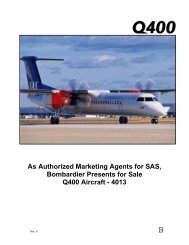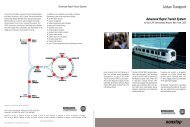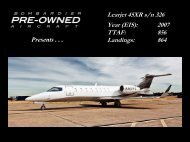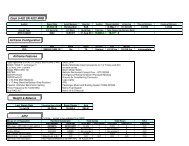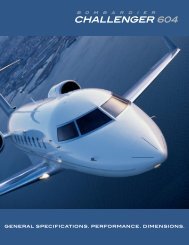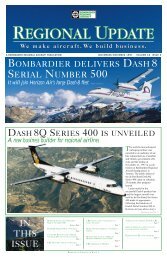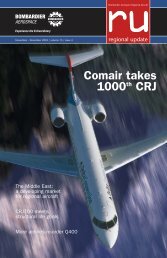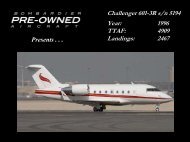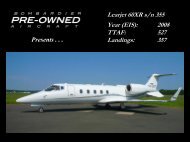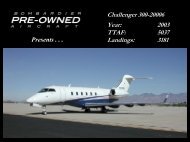Q400 Approved for London City - Bombardier
Q400 Approved for London City - Bombardier
Q400 Approved for London City - Bombardier
Create successful ePaper yourself
Turn your PDF publications into a flip-book with our unique Google optimized e-Paper software.
<strong>Bombardier</strong> Aerospace Regional Aircraft<br />
<strong>Q400</strong> <strong>Approved</strong> <strong>for</strong><br />
<strong>London</strong> <strong>City</strong><br />
regional update<br />
September 11, 2001<br />
We have all been profoundly affected by the recent September 11 attacks<br />
in the United States. The men and women of <strong>Bombardier</strong> Aerospace extend<br />
our deepest sympathies to the families and friends of the thousands of innocent<br />
people who lost their lives.<br />
We offer our heartfelt appreciation, to those who risked—and many who<br />
lost—their lives in an attempt to rescue survivors of this tragedy. They are true<br />
heroes and deserve the commendation of people everywhere.<br />
Many in our industry have felt these effects in a very personal way as we<br />
struggle with the aftershocks. I would like to express our solidarity with those<br />
friends and colleagues who have felt the pain, but also state our resolve to<br />
triumph over adversity. The aviation, aerospace, airline and regional airline<br />
businesses are the most resilient in the world—together, we will overcome our<br />
losses to see the better days and bluer skies that will eventually come.<br />
First Production<br />
CRJ900 Ready<br />
to Fly<br />
Steven A. Ridolfi<br />
President<br />
<strong>Bombardier</strong> Aerospace, Regional Aircraft<br />
OCTOBER • NOVEMBER 2001<br />
VOLUME14 • ISSUE 2<br />
www.aero.bombardier.com
<strong>London</strong><strong>City</strong> and the <strong>Q400</strong>—<br />
A Perfect Fit<br />
<strong>Bombardier</strong>’s <strong>Q400</strong> has been approved by the<br />
JAA <strong>for</strong> steep-approach operations at <strong>London</strong><br />
<strong>City</strong> Airport (LCY), making possible a higher<br />
level of service <strong>for</strong> airlines and their passengers.<br />
Said Steven A. Ridolfi, President of <strong>Bombardier</strong> Aerospace, Regional Aircraft,<br />
“This is a great opportunity <strong>for</strong> airlines using <strong>London</strong> <strong>City</strong> to<br />
grow their business with the <strong>Q400</strong>. It offers 70-plus seat capacity,<br />
jet-like speed, the range to reach more destinations, superior passenger<br />
com<strong>for</strong>t and the lowest operating cost per seat of all aircraft<br />
operating at that airport. That is clearly a winning combination."<br />
Augsburg Airways said it will begin <strong>Q400</strong> service between <strong>London</strong><br />
<strong>City</strong> and Munich as soon as the airline receives approval from the<br />
German regulatory authority, expected sometime in October, 2001.<br />
The Docklands airport, which opened <strong>for</strong> business in October of<br />
1987 (with a de Havilland Dash 7), has experienced explosive growth<br />
in aircraft movements and passenger traffic. Passenger traffic grew<br />
by 170% between 1995 and 2000, with 1.5 million passengers using<br />
the convenient airport last year. While 3.5 million passengers a year<br />
are expected to flow through LCY by 2010, aircraft movements will<br />
be capped at 73,000 per year in 2003, up from 50,000 in 2000. The<br />
current average seat capacity of 55 among aircraft currently using<br />
the airport will have to grow to 70 or more seats to remain within<br />
the limit on aircraft movements.<br />
And LCY passenger traffic is prime traffic. In 2000, 64% of total<br />
passengers paid business class fares (more than that of other <strong>London</strong><br />
airports) and 55% of those travelled with hand luggage only. The<br />
airport’s proximity to Central <strong>London</strong> and 10-minute check-in times<br />
has undoubtedly attracted these passengers.<br />
With the <strong>for</strong>ecast growth in passenger traffic, it seems obvious<br />
that pressure will be placed on airlines to provide more destinations,<br />
and some further afield than the June 2001 average of 404 nm (748<br />
km) to the 27 destinations served from LCY.<br />
If an airline’s business class passengers want business class amenities<br />
on the aircraft, the <strong>Q400</strong> can provide them. A wide mix of seating<br />
configurations and seat pitch is available, including three abreast<br />
business class seating. The <strong>Q400</strong> galleys can serve the quality of inflight<br />
food and drink that European business travellers have come<br />
to expect.<br />
With its 360-knot cruise speed, the <strong>Q400</strong> can reach additional<br />
destinations within a 60-minute flight. At about 305 nm (565 km),<br />
the 60-minute range is within 5 nm (9 km) of that of the RJX-85<br />
four-engine jet, and about 55 nm (102 km) further than that of a similarly-sized<br />
competitive turboprop currently operating at LCY.<br />
Airport turnaround time with 70 passengers is only 18 minutes,<br />
including loading enough fuel <strong>for</strong> four 200-nm (370 km) sectors.<br />
For airlines that want to fly greater distances from LCY, the <strong>Q400</strong><br />
will fly 425 nm (787 km) with 70 passengers, 600 nm (1 100 km) with<br />
65 passengers, and 800 nm (1 482 km) with 60 passengers. There are<br />
dozens of markets less than 600 nm from LCY that are served from<br />
other <strong>London</strong> airports; the <strong>Q400</strong> brings them within com<strong>for</strong>table<br />
range of <strong>London</strong> <strong>City</strong>. In addition, the <strong>Q400</strong> breaks even on most<br />
sectors with only 30 seats filled.<br />
The Noise and Vibration Suppression (NVS) system is exclusive<br />
to Q Series aircraft. With cabin noise and vibration levels close to<br />
those of a jet with rear-mounted engines, the Q Series aircraft are<br />
the most com<strong>for</strong>table of all propeller-driven aircraft. The <strong>Q400</strong> is<br />
quiet outside, too. Take-off propeller rpm is a noise-reducing 1,050<br />
and, at the cruise setting of 850 rpm, passengers can almost count<br />
the propeller blades as they turn. People on the ground might not even<br />
notice the aircraft’s passing.<br />
There are only a handful of aircraft that qualify <strong>for</strong> the 5.5-degree<br />
glideslope at <strong>London</strong> <strong>City</strong> Airport, and only one complete family of<br />
aircraft with from 37 to 70-plus seats: the 37- to-39 seat Q200, 50-<br />
to 56-seat Q300 and 68- to 78-seat <strong>Q400</strong>. That means complete<br />
market coverage with unmatched commonality. Airlines with all<br />
three models can match capacity to demand. The three models carry<br />
2<br />
<strong>Bombardier</strong> Aerospace Regional Aircraft
The <strong>Q400</strong> demonstrator in the<br />
ramp lineup outside the terminal<br />
at <strong>London</strong> <strong>City</strong>’s “Docklands”<br />
airport earlier this year.<br />
British European is one of the other airlines also considering <strong>Q400</strong> service into <strong>London</strong> <strong>City</strong>.<br />
a single type rating, and can be<br />
flown by a common pool of<br />
pilots. There are also common<br />
maintenance and training procedures,<br />
common ground support<br />
equipment, and common product<br />
support. That commonality<br />
can add up to $12.71 million in<br />
savings over 15 years, based on<br />
a fleet of five Q300 and five <strong>Q400</strong><br />
aircraft, as opposed to ten noncommon<br />
aircraft.<br />
And those lower direct operating<br />
costs? For the <strong>Q400</strong>, it’s 3.8 US cents<br />
per airplane seat-kilometre, based<br />
on 70 seats. Compare that to 5.2<br />
cents <strong>for</strong> the 85-seat BAe 146, 4.8<br />
cents <strong>for</strong> the 82-seat RJ85, 4.5 cents<br />
<strong>for</strong> the 85-seat RJX-85, 5.3 cents <strong>for</strong><br />
the 50-seat Fokker 50 and 5.0 cents<br />
<strong>for</strong> the Saab 2000.<br />
The <strong>Q400</strong> at LCY is once again<br />
changing how people think about<br />
turboprops—<strong>for</strong> the better.<br />
Minor Mods<br />
<strong>for</strong> LCY<br />
One switch and two<br />
supplements to the<br />
Airplane Flight Manual<br />
(AFM), plus compliance<br />
with a Service Bulletin<br />
are all that is required to equip the <strong>Q400</strong> <strong>for</strong> operations at <strong>London</strong> <strong>City</strong> Airport.<br />
A cockpit switch allows the pilots to "tell" the Enhanced Ground Proximity<br />
Warning System (EGPWS) that it’s quite all right to descend on a 5.5-degree<br />
glideslope at a flap setting of 35 degrees. Otherwise, the system would sound<br />
a "descent rate" alert.<br />
A microswitch <strong>for</strong> the flap selector confirms that Flap 35 has been selected.<br />
The basic ILS function of the IMS100 avionics suite proved to be acceptable at<br />
5.5 degrees, and required only compliance "paper" adjustments to be approved.<br />
<strong>Q400</strong>: the Good Neighbour Airplane<br />
SAS Commuter’s flight operations mission statement demands compliance with<br />
all environmental impact laws; reduced fuel consumption; reduced emissions of carbon<br />
dioxide and nitrogen oxide, and; reduced community noise.<br />
The airplane that met all of those conditions was <strong>Bombardier</strong>’s <strong>Q400</strong>, now<br />
flying in the colors of SAS Commuter as well as Augsburg Airways, Horizon Airways,<br />
British European, Tyrolean Airways and, soon, Widerøe’s Flyveselskap.<br />
Smoke emissions from the <strong>Q400</strong> are only 60% of the FAR Part 34 requirements<br />
<strong>for</strong> turboprops, and well below visibility levels. Likewise, gaseous emissions are<br />
60% of those allowed in ICAO Annex 16—also well below visibility levels.<br />
The <strong>Q400</strong> propellers turn at only 1,020 rpm on take-off and approach, and the<br />
climb per<strong>for</strong>mance of the aircraft is superb... <strong>for</strong> a much reduced noise footprint.<br />
Acoustical treatment of the APU and ACM<br />
systems reduces their noise significantly, while<br />
APU exhaust is directed upwards. The result is a<br />
more com<strong>for</strong>table environment <strong>for</strong> everyone.<br />
SAS Commuter has<br />
strict environmental<br />
standards, which the<br />
<strong>Q400</strong> meets<br />
Regional Update October-November 2001 3
<strong>Q400</strong> Drives Widerøe<br />
Expansion Plans<br />
Having built its business with de Havilland and <strong>Bombardier</strong> products <strong>for</strong> close to<br />
fifty years, Widerøe’s Flyveselskap ASA of Norway again turned to <strong>Bombardier</strong> <strong>for</strong><br />
the next phase of its growth plans.<br />
Martin Lohne<br />
Vice-president, Public Relations<br />
Widerøe<br />
It will put the first of its new 72-<br />
seat <strong>Q400</strong> aircraft into service on<br />
the Stavenger, Norway-Aberdeen,<br />
Scotland "oil route" later this fall,<br />
with two daily round trips in addition<br />
to the current once-daily<br />
flight by a Q300.<br />
The second of three firmordered<br />
<strong>Q400</strong> aircraft will fly Torp,<br />
Norway-Copenhagen, Denmark<br />
when it is delivered during the 2nd<br />
quarter of 2002. The routes <strong>for</strong> the<br />
third <strong>Q400</strong>, earmarked <strong>for</strong> delivery<br />
in late summer 2002, have not<br />
been announced. Widerøe, the fifth<br />
European carrier to order the <strong>Q400</strong>,<br />
holds options on an additional five<br />
airliners. If those options are exercised,<br />
the airline will likely add<br />
additional <strong>for</strong>eign destinations to<br />
its route system.<br />
Selection of the <strong>Q400</strong> was based<br />
on Widerøe’s strategy to remain a<br />
regional airline operating aircraft<br />
no larger than 75 seats, and no<br />
smaller than the 37 seats of its current<br />
Dash 8 Series 100 turboprops,<br />
of which it operates 18. The nine<br />
50-seat Dash 8 Series 300/Q300<br />
aircraft in the fleet fill the middle<br />
of the seating range.<br />
“We evaluated many aircraft,<br />
including jets, be<strong>for</strong>e settling on the<br />
<strong>Q400</strong>," said Martin Lohne,<br />
Widerøe’s Vice-president, Public<br />
Relations. “Its size, near-jet speeds,<br />
passenger com<strong>for</strong>t, turboprop economics<br />
and commonality with the<br />
rest of our fleet were the main reasons<br />
<strong>for</strong> selecting the aircraft."<br />
Widerøe’s <strong>Q400</strong><br />
aircraft are configured<br />
almost identically<br />
to those of SAS<br />
Commuter; cockpit<br />
instrumentation is<br />
exactly the same.<br />
SAS owns 63.3% of<br />
Widerøe, so there is<br />
close co-operation<br />
between the two<br />
carriers. The common<br />
<strong>Q400</strong> fleet will allow<br />
Widerøe and SAS Commuter to<br />
exchange spares. Widerøe is part<br />
of the SAS "Well Connected" concept<br />
that also includes airBaltic, Air<br />
Botnia, Cimber Air and Skyways.<br />
With both Q Series and older<br />
Dash 8 aircraft in its fleet,<br />
Widerøe employees and passengers<br />
notice the considerable difference.<br />
“Both groups comment<br />
favorably on the lower noise and<br />
higher com<strong>for</strong>t levels in our Q300<br />
aircraft. The Noise and Vibration<br />
Suppression (NVS) system works<br />
extremely well."<br />
The closing of Oslo’s almostdowntown<br />
Fornebu Airport and<br />
the opening of Gardermoen,<br />
almost an hour’s drive north of the<br />
city, provided the impetus <strong>for</strong><br />
Widerøe to develop<br />
a hub at Torp Airport.<br />
It’s almost a<br />
two hour drive<br />
southwest of Oslo,<br />
and the centre of<br />
burgeoning growth<br />
in residential and<br />
diversified exportoriented<br />
industrial<br />
development.<br />
Today, Widerøe<br />
has 25 daily departures<br />
from Torp – compared to 15<br />
at Gardermoen – and serves both<br />
Copenhagen and Stockholm, plus<br />
the three most important domestic<br />
destinations, from that airport.<br />
“Torp is the fastest growing<br />
airport in Norway," said Mr.<br />
Lohne, “and we have 50% of the<br />
total daily departures." Widerøe<br />
is also a dominant airline in the<br />
country; with 90,000 flights it carried<br />
about 1.5 million passengers<br />
last year, or about one-third of<br />
Norway’s population of 4.5 million.<br />
Despite its growth in southern<br />
Norway and its expansion to some<br />
new international destinations,<br />
Widerøe has not neglected its<br />
roots in the northern and western<br />
parts of the country. It continues<br />
regularly-scheduled service to<br />
several airports with 2,600-foot<br />
(800 m) airstrips along the Norwegian<br />
Sea coast to Honningsvaag,<br />
north of the 70th<br />
parallel. These are flown primarily<br />
by Dash 8 Series 100 aircraft,<br />
which replaced Twin Otter and<br />
Dash 7 equipment. Widerøe also<br />
flies what might be the shortest<br />
scheduled sector in the world, the<br />
eight-minute hop from Vadsoe to<br />
Kirkenes across Varangerfjorden,<br />
an inlet of the Barents Sea. To<br />
drive between the two points<br />
means a three-hour trip around<br />
the fjord.<br />
Widerøe’s five-year plan?<br />
“We will continue to be the<br />
leading player serving the stolports<br />
in the north and west," said Mr.<br />
Lohne. “We will have expanded<br />
our Q300 and <strong>Q400</strong> services to<br />
new destinations in southern<br />
Norway and abroad, with annual<br />
growth in passengers and revenues."<br />
4<br />
<strong>Bombardier</strong> Aerospace Regional Aircraft
Widerøe pilots picking up their first de Havilland<br />
Canada DHC-3 Otter in 1954 in Toronto.<br />
Now that’s<br />
reliability!<br />
Capt. Johan Stormo has<br />
spent almost 30 years<br />
and 14,500 hours flying<br />
de Havilland or<br />
<strong>Bombardier</strong> aircraft <strong>for</strong><br />
Widerøe’s Flyveselskap<br />
of Norway. In all of<br />
those years and hours,<br />
"I have never had an engine failure, never a<br />
precautionary engine shutdown, never any<br />
serious technical problem with the aircraft.“<br />
Most of his flying has been in Norway’s<br />
northern regions, where short airstrips,<br />
hostile terrain and often malicious weather<br />
can play havoc with man and machine.<br />
It’s a strong endorsement of the reliability<br />
and integrity of the de Havilland/<strong>Bombardier</strong><br />
aircraft Capt. Stormo has flown: DHC-3<br />
Otter, DHC-6 Twin Otter, Dash 7, Dash 8<br />
Series 100 and 300/Q300. He was at<br />
FlightSafety International in Toronto<br />
recently to take the differences course<br />
required to add the <strong>Q400</strong> to his collection.<br />
"Fantastic per<strong>for</strong>mance," he said<br />
following his last ride in the simulator.<br />
"In a single-engine climb, you have to<br />
throttle back when you reach 6,000 feet<br />
(1 828 m), or you’ll overspeed."<br />
Capt. Stormo already had about 1,000<br />
hours in the single-engine Otter when he<br />
joined Widerøe in 1971, following a brief<br />
stint in the Royal Norwegian Air Force. He<br />
immediately checked out as a co-pilot on<br />
the Twin Otter at Bodø—where he is still<br />
based—and later upgraded to captain. He<br />
spent 7,350 hours on the Twin Otter flying<br />
in and out of 2,600-foot (800 m) airstrips.<br />
When the four-engine Dash 7 came<br />
to Widerøe in 1982, Capt. Stormo again<br />
upgraded, and spent 3,000 hours flying<br />
an aircraft that, he said, flew just like the<br />
Twin Otter. The 50-passenger Dash 7 was<br />
simply bigger.<br />
Another 3,000-hour career-withina-career<br />
began in 1993 when Widerøe<br />
received its first Dash 8-100, and later the<br />
Series 300. He also served as an instructor<br />
on the Twin Otter, Dash 7 and Dash 8.<br />
Now that the <strong>Q400</strong> is joining the fleet,<br />
Capt. Stormo, who is also the airline’s JAR<br />
Ops co-ordinator, will be busy writing the<br />
operations manual <strong>for</strong> the aircraft.<br />
"This is a great airplane to fly," he said.<br />
"The passengers will like it too, because it’s<br />
fast and it’s quiet inside."<br />
First production CRJ900 set<br />
<strong>for</strong> initial flight<br />
Program is on schedule <strong>for</strong> certification<br />
T HE FIRST PRODUCTION CRJ900<br />
Series regional jet, serial number<br />
15001, is in the final preparations<br />
<strong>for</strong> its first flight, scheduled <strong>for</strong><br />
October, 2001 at Montreal’s<br />
Mirabel International Airport<br />
where the CRJ700 and CRJ900 are<br />
assembled. The aircraft will have a<br />
complete interior with the baseline<br />
86 seats, and will be used <strong>for</strong> systems<br />
integration.<br />
SN 15001 will later be flown to<br />
the <strong>Bombardier</strong> Aerospace Flight<br />
Test Center in Wichita, Kansas<br />
where it will join the CRJ900 prototype,<br />
SN 15991 in the flight test<br />
program. As of September 10,<br />
2001, 15991 had flown 316 hours<br />
in 128 flights.<br />
“There have been no major technical<br />
issues that will delay certification,<br />
scheduled <strong>for</strong> the third<br />
quarter of 2002," said David Tidd,<br />
CRJ900 Program Director. “Stability<br />
and control testing is virtually<br />
complete, and Transport Canada<br />
pilots have flown the aircraft."<br />
As <strong>for</strong> the aircraft’s handling<br />
qualities, “the pilots say they are<br />
pretty much identical to those of<br />
the CRJ700, in some cases better,"<br />
Mr. Tidd added. Ventral fins were<br />
added to the aft fuselage of the<br />
CRJ900 to improve lateral stability.<br />
In addition to a fuselage stretch<br />
of the CRJ700, the CRJ900 has more<br />
powerful General Electric CF34-8C5<br />
engines, and an extra “stack" in the<br />
main landing gear brakes.<br />
Aircraft SN 15002 is scheduled<br />
<strong>for</strong> roll-out in the 1st quarter of<br />
2002. That aircraft will have 90<br />
passenger seats, <strong>for</strong> which the aircraft<br />
will be certificated. It is<br />
expected to be on display at the<br />
‰ <strong>Bombardier</strong>’s <strong>Q400</strong> has been flown at an altitude of<br />
36,000 feet (10 973 m) above sea level in an assessment of<br />
the aircraft’s capability to per<strong>for</strong>m specialized, non-airline<br />
missions requiring high-altitude, low-speed capabilities.<br />
"Our Q200 and Q300 aircraft operate in a variety of<br />
special mission configurations and the <strong>Q400</strong> high altitude<br />
tests and other work to expand the operating<br />
envelope confirm our interest in adapting the <strong>Q400</strong> <strong>for</strong><br />
non-airline missions," said Steven A. Ridolfi, President of<br />
<strong>Bombardier</strong> Aerospace, Regional Aircraft. "The ability of<br />
the <strong>Q400</strong> to per<strong>for</strong>m successfully at jet aircraft altitudes<br />
holds great potential <strong>for</strong> many new applications."<br />
On one simulated mission, with the temperature at ISA, the<br />
<strong>Q400</strong> took off at 60,000 pounds (27 216 kg) including<br />
15,724 pounds (6 928 kg) of fuel. Simulating a payload of<br />
Farnborough International Air<br />
Show in the U.K. next July with the<br />
baseline 86-seat interior. The aircraft<br />
will not participate in the<br />
flight test program unless required.<br />
SN 15002 will also be the first<br />
customer aircraft. It is scheduled<br />
<strong>for</strong> delivery to launch airline customer<br />
Mesa Airlines in the 1st<br />
quarter of 2003. Mesa has firm<br />
orders <strong>for</strong> 20 CRJ900 aircraft,<br />
while GECAS has firm orders <strong>for</strong><br />
10. Memoranda of Understanding<br />
and options number 82 <strong>for</strong> a<br />
CRJ900 program total of 112 aircraft.<br />
“The CRJ900 is under the published<br />
operational empty weight of<br />
47,500 pounds (21 546 kg)," said<br />
Mr. Tidd. “In addition, indications<br />
are that the aircraft will meet published<br />
per<strong>for</strong>mance figures."<br />
When the CRJ900 is awarded a<br />
“same type" rating in 2002, the<br />
concept of a CRJ family of<br />
common aircraft will be fully realized.<br />
The differences training<br />
required when transitioning from<br />
the CRJ100/200 to the CRJ700 or<br />
CRJ900 is three days, with no simulator<br />
training required. Transitioning<br />
from the CRJ700 to CRJ900<br />
will require only a one-day course,<br />
again with no simulator time.<br />
At <strong>Bombardier</strong> Aerospace,<br />
Regional Aircraft Technical Publications,<br />
CRJ700 documentation is<br />
being modified to include the<br />
CRJ900 <strong>for</strong> common CRJ700/900<br />
aircraft maintenance manuals,<br />
illustrated parts catalogues and<br />
other technical documents.<br />
These will all be distributed on<br />
DVD disks to SGML language standards<br />
with hyperlinks to other sections<br />
of the manuals where<br />
required. The Aircraft Flight<br />
Manual and Maintenance Requirement<br />
Manual will be dedicated<br />
CRJ900 publications.<br />
The existing Level D CRJ700<br />
full-flight simulator at <strong>Bombardier</strong>’s<br />
training facilities in Montreal will<br />
become a convertible CRJ700/900<br />
device. Simulator certification as<br />
a CRJ900 device is scheduled <strong>for</strong><br />
the 3rd quarter of 2002.<br />
<strong>Q400</strong> reaches new heights, as special missions roles are explored<br />
10,000 pounds (4 536 kg), the aircraft climbed to 35,000<br />
feet (10 668 m) in 35 minutes at maximum climb power,<br />
covering 147 nm (272 km).<br />
After a one-hour positioning flight, the aircraft remained<br />
on-station <strong>for</strong> six hours, 42 minutes (1,772 nm/2 170 km) at<br />
an average speed of 264 kts (489 km/h). The aircraft then<br />
flew back to top of descent at maximum endurance speed<br />
and descended from 35,000 feet to a landing in 32 minutes<br />
(117 nm/217 km/h). Fuel on landing was 933 pounds (423 kg).<br />
The <strong>Q400</strong> has already demonstrated that it can handle<br />
steep 5.5-degree approaches, such as those at <strong>London</strong> <strong>City</strong><br />
Airport, and take off and land at high altitude airports such<br />
as La Paz, Bolivia at 13,300 feet (4 054 m) asl. The demonstrated<br />
high cruise altitude capability of the <strong>Q400</strong> provides<br />
further evidence of its multi-mission potential.<br />
A CRJ900 leaves its hanger<br />
<strong>for</strong> a test flight.<br />
Regional Update October-November 2001 5
CRJ700 is the answer<br />
<strong>for</strong> Brit Air<br />
Xavier Leclercq<br />
President, Brit Air<br />
Brit Air of Morlaix, France joined the regional jet revolution when<br />
it put its first 50-seat CRJ100 into revenue service in 1995. Now<br />
operating a fleet of 20 CRJ100 and 200 Series jets, Brit Air says the<br />
CRJ has had a major impact on its route structure by capitalizing<br />
on jet speeds to increase frequency, which in turn has resulted in<br />
overall higher load factors.<br />
The airline is further building on its regional jet success with the<br />
70-seat CRJ700, which Brit Air put into revenue service in the<br />
spring of 2001. Brit Air had four CRJ700 aircraft, from a firm order<br />
<strong>for</strong> 12, in operation by October of 2001.<br />
“The CRJ700 has very good customer appeal, and is the right<br />
answer to the growth of our route network and passenger traffic,"<br />
said Xavier Leclercq, President of Brit Air. "Also, it arrived at the<br />
right time—well in advance of its competitors."<br />
While Brit Air is headquartered in Morlaix, a town of about<br />
20,000 people, its main operating base is at Lyon, dedicated to<br />
short- and medium-haul flights throughout Europe. Forty-five<br />
per cent of Brit Air flights arrive at or depart from Lyon, representing<br />
about 25 per cent of all airline movements at that airport.<br />
About 70 per cent of Brit Air traffic to the 26 destinations it<br />
serves is comprised of business travellers, with about 50 per cent<br />
of those passengers connecting to other AF-coded flights. (Brit Air<br />
Carrying the Air France AF code (Air France is Brit Air’s major<br />
shareholder), the 70-seat jets are flying Brest-Lyon, Caen-Lyon,<br />
Genoa-Paris Charles de Gaulle and Nantes-Toulouse, usually three<br />
times a day. Traffic on those routes has grown too large to be<br />
served efficiently by smaller aircraft in the Brit Air fleet.<br />
The airline’s CRJ pilots regularly switch between the 50- and 70-<br />
seat models. “That and the many other areas of commonality was<br />
a major reason why we acquired the CRJ700," said Mr. Leclercq.<br />
“The cost savings are significant."<br />
Brit Air’s CRJ fleet is equipped with the head-up guidance<br />
system (HGS) which will provide CAT IIIa capability. “We have 20<br />
to 30 days a year when CAT IIIa weather conditions prevail at certain<br />
airports and having the ability to operate makes us as reliable<br />
and efficient as any major airline," said Mr. Leclercq. “CAT IIIa<br />
capability is absolutely imperative at Lyon."<br />
faces competition from France’s high-speed TGV train service on<br />
10 per cent of its routes).<br />
Xavier Leclercq started Brittany Air, doing business as Brit<br />
Air, with two five-seat Piper Pa-23 Aztecs in 1973. The airline now<br />
has a fleet of 39 aircraft: 20 CRJ100/200, four CRJ700, eight Fokker<br />
F100 and seven ATR turboprops, as well as more than 1,100<br />
employees.<br />
“In the next three years, we will become an all-jet airline with<br />
a mix of aircraft from 50 to 100 seats," said Mr. Leclercq.<br />
The company will also remain based in Morlaix. “With modern<br />
communications, there is no need <strong>for</strong> the administrative offices<br />
to be at the same base as the airplanes," Mr. Leclercq said.<br />
“Also, it (the CRJ700) arrived at the right time<br />
—well in advance of its competitors."<br />
6<br />
<strong>Bombardier</strong> Aerospace Regional Aircraft
Supplier Liaison: The People in the Middle<br />
SupplierLiaison is the department in<br />
<strong>Bombardier</strong> Aerospace, Regional<br />
Aircraft that acts as the intermediary<br />
between suppliers and operators<br />
of the CRJ, Dash 8/Q Series<br />
and out-of-production products.<br />
“We act on behalf of both suppliers<br />
and operators," said Simon<br />
Pianarosa, Manager, Supplier Liaison.<br />
His seven-person team consists<br />
of Dale Maxwell, Everey<br />
Thomas and Lyndsay Lentine on<br />
the Dash 8 side in Toronto, and<br />
Marilyn Thomas, Josee Lacroix,<br />
Dana Zafiris and Gabor Hasko on<br />
the CRJ program in Montreal.<br />
“If an operator has been unable<br />
to resolve his problems with a supplier,<br />
he will come to us <strong>for</strong> help<br />
in arriving at a solution," said Mr.<br />
Pianarosa. “We’ll ensure that the<br />
supplier is adhering to his contractual<br />
obligations to <strong>Bombardier</strong>,<br />
then encourage the supplier to<br />
work with the operator to settle the<br />
issue.<br />
“We also help our suppliers by<br />
helping resolve warranty issues,<br />
and by letting them know that an<br />
operator has taken delivery of an<br />
aircraft."<br />
Supplier Liaison has developed<br />
a Supplier In<strong>for</strong>mation Manual<br />
that provides a wealth of in<strong>for</strong>mation<br />
about the hundreds of suppliers<br />
of the thousands of parts<br />
that make up an aircraft.<br />
The manuals<br />
contain training<br />
requirements, repair<br />
facility in<strong>for</strong>mation,<br />
warranty expectations,<br />
etc.<br />
“This in<strong>for</strong>mation –<br />
all an operator needs<br />
to know about supplier<br />
contacts – is currently<br />
on a CD-ROM <strong>for</strong> the<br />
<strong>Q400</strong> program," said<br />
Mr. Pianarosa. “Our<br />
plan is to bundle this<br />
in<strong>for</strong>mation on the<br />
technical publications<br />
DVD disk in the first<br />
quarter of 2002, and then to have<br />
the in<strong>for</strong>mation on-line through a<br />
dedicated web site by the end of<br />
2002."<br />
Supplier Liaison has begun<br />
working with suppliers to monitor<br />
low-reliability parts, and<br />
develop action plans with the suppliers<br />
to best satisfy the operator’s<br />
needs. These plans will include<br />
putting parts on consignment at<br />
the operator’s facilities, to minimize<br />
the impact of an unscheduled<br />
removal of a critical<br />
component.<br />
Mr. Pianarosa’s department is<br />
also starting to measure supplier<br />
per<strong>for</strong>mance on a monthly basis,<br />
covering such items as AOG support<br />
– whether it is four hours, 24<br />
hours or more than 24 hours –<br />
repair turnaround times, spares fill<br />
rates from supplier directly to<br />
operator, etc., as a result of a<br />
survey supplied by operators<br />
focusing on their experiences with<br />
supplier delivery, costs, satisfaction<br />
and quality.<br />
The first suppliers to be evaluated<br />
in this process are BE Aerospace,<br />
C&D Interiors, Honeywell and<br />
Thales. The results will be published<br />
in a new Customer Support<br />
department publication called<br />
“Regional SPIN" (Supplier Per<strong>for</strong>mance<br />
In<strong>for</strong>mation Newsletter),<br />
the first issue of which will be<br />
published in October 2001.<br />
“We will be evaluating four<br />
different suppliers each quarter<br />
and following up with an annual<br />
review on how they have been<br />
doing, classifying them based on<br />
their per<strong>for</strong>mance," said Mr.<br />
Pianarosa. “Co-operation from<br />
the suppliers to date has been<br />
very good. It gives them better visibility<br />
with the operators and lets<br />
them know what the operators<br />
think of their support.<br />
“We want to be the best in what<br />
we do, and we can’t be the best<br />
unless our suppliers are the best,"<br />
he said.<br />
Supplier Liaison<br />
<strong>Bombardier</strong> Aerospace and<br />
BE Aerospace staff sit in seats<br />
made by the supplier.<br />
First Row (left to right):<br />
Gabor "Gabi" Hasko,<br />
Dale Maxwell, Dana Zafiris<br />
2nd Row:<br />
Lyndsay Lentine, Josee<br />
Lacroix, Marylin Thomas<br />
3rd Row:<br />
Everey Thomas,<br />
Simon Pianarosa<br />
4th Row :<br />
Steve Young<br />
Q300 makes a<br />
smooth introduction<br />
at Air Nostrum<br />
‰ Despite being a new operator of<br />
the 50- 56-seat Q300 and its rapid<br />
introduction of aircraft into the fleet,<br />
Air Nostrum of Spain has been chalking<br />
up some impressive dispatch<br />
reliability rates.<br />
Air Nostrum began taking delivery<br />
of the 29 Q300 aircraft on order in<br />
December, 2000. By April, 2001 five<br />
Q300 aircraft were flying about1,000<br />
flights a month with a dispatch reliability<br />
in excess of 99%. The addition<br />
of more aircraft didn’t alter the<br />
dispatch reliability much. In July, the<br />
fleet flew 1,332 cycles with a reliability<br />
of 99.55%.<br />
That means that only eight of<br />
those 1,332 flights were delayed or<br />
cancelled because of a technical fault<br />
with the Q300.<br />
“The per<strong>for</strong>mance experienced by<br />
Air Nostrum demonstrates that the<br />
Q Series is technically mature and ready<br />
<strong>for</strong> hard work from the first day of<br />
service,” said Gordon Pratt, Director<br />
of the Q Series 100/200/300 Programs.<br />
Regional Update October-November 2001 7
Representatives from General<br />
Electric Capital Aviation Services<br />
(GECAS) and <strong>Bombardier</strong> mark<br />
the deliver y of the first GECAS<br />
CRJ200. The jet will be leased to<br />
Shandong Airlines in whose<br />
colours it is painted.<br />
Left to right: Nicky Sarandiev,<br />
Mike MacConnie, Mike Casey,<br />
Todd Freeman, Henry Hubschman,<br />
Steven Ridolfi, Cam Mountenay,<br />
John Giraudy, Edward Sun and<br />
Neville Taylor .<br />
CRJ and Q Series deliveries<br />
Twelve customers took delivery of 39 CRJ Series jets and Q Series<br />
turboprops between June 1 and September 20, 2001.<br />
CRJ200 Series: Air Nostrum accepted one aircraft, its ninth from an order <strong>for</strong> 21.<br />
Atlantic Coast Airlines received seven aircraft, increasing its fleet to 51 aircraft of the<br />
96 on order. Atlantic Southeast Airlines, a Delta Connection carrier, took delivery of<br />
three, the 6th, 7th and 8th from the 38 on order. Northwest Airlines, which has placed<br />
orders <strong>for</strong> 34, received seven to increase its fleet to 23. The last of five CRJ200 aircraft<br />
ordered by Shandong Airlines was delivered. The SkyWest Airlines fleet of CRJ200 aircraft<br />
grew to 22 after two deliveries; the airline has orders <strong>for</strong> 100.<br />
CRJ700 Series: Launch customer Brit Air has orders <strong>for</strong> 10, and took delivery of its<br />
fourth. U.S. launch customer Horizon Airlines took three of its firm order <strong>for</strong> 30, giving<br />
it four aircraft. Lufthansa <strong>City</strong>Line accepted three aircraft: 2nd, 3rd and 4th from an<br />
order <strong>for</strong> 19.<br />
Q300: Three were delivered to Air Nostrum to increase its fleet to nine; 29 have been<br />
ordered. UNI Air took delivery of its one aircraft on order.<br />
<strong>Q400</strong>: Augsburg Airways has ordered five aircraft and took delivery of the third. U.S.<br />
launch customer Horizon Airlines took four more to increase its fleet to eight of the 15<br />
on order. SAS Commuter, which has ordered 28 aircraft, took delivery of two, giving it 23<br />
delivered to date.<br />
Q Series Dash 8 Facts and Figures<br />
Sales (October 1, 2001) Delivered Backlog Total<br />
Series 100 298 1 299<br />
Series 200 92 2 94<br />
Series 300 180 25 205<br />
Series 400 44 27 71<br />
Program total 614 55 669<br />
Q Series Dash 8 Fleet Statistics<br />
Aircraft in service 565 (at April, 2001)<br />
Average flight time 49 mins. (at April, 2001)<br />
Average annual utilization (hours/cycles) 2,167/2,580 (at April,2001)<br />
Highest annual utilization (hours/cycles) 3,208/4,858 (at April, 2001)<br />
Fleet total hours 10,507,951 (at April, 2001)<br />
Fleet total cycles 12,718,855 (at April, 2001)<br />
Dispatch reliability 98.8% (12 mos. to April, 2001)<br />
Schedule completion rate 98.9% (12 mos. to April, 2001)<br />
CRJ Series Facts and Figures<br />
Sales (October 1, 2001) Delivered Backlog Total<br />
Series 100 226 0 226<br />
Series 200 301 335 636<br />
Series CRJ440 0 75 75<br />
Series 700 12 183 195<br />
Series 900 0 30 30<br />
Corporate variants 13 2 15<br />
Program total 552 625 1177<br />
CRJ Series Fleet Statistics*<br />
Aircraft in service 511 (at June, 2001)<br />
Average flight time 1.1 hrs. (at June, 2001)<br />
Average annual utilization (hours/cycles) 2,426/2,119 (at June, 2001)<br />
Highest annual utilization (hours/cycles) 4,292/3,348 (at June, 2001)<br />
Fleet total hours* 3,777,771 (at June, 2001)<br />
Fleet total cycles* 3,345,049 (at June, 2001)<br />
Dispatch reliability 98.28% (12 mos. to June, 2001)<br />
Schedule completion rate 99.08% (12 mos. to June, 2001)<br />
<strong>Bombardier</strong>, ideas that fly<br />
President: Steven A. Ridolfi<br />
Senior Vice-president, Sales: John Giraudy<br />
Vice-president, Sales, Asia/Pacific: Walter Galloway<br />
Vice-president, Sales, International: John Howarth<br />
Vice-president, Sales, The Americas: Ric Allison<br />
* Does not include corporate/business operators. Utilization is based on schedule data.<br />
Regional Update is published by:<br />
<strong>Bombardier</strong> Aerospace, Regional Aircraft<br />
123 Garratt Boulevard<br />
Downsview, Ontario, Canada M3K 1Y5<br />
Tel: (416) 375-4027<br />
Fax: (416) 375-4540<br />
<strong>Bombardier</strong> Inc. 2001 Printed in Canada<br />
Copyright<br />
©<br />
In<strong>for</strong>mation, technical data and per<strong>for</strong>mance figures in this publication are subject to change without notice. This publication does not intend to convey any guarantees or warranties. Any guarantees or warranties on any subject are extended<br />
to customers only as may be provided in their purchase agreements. Articles in Regional Update may be reproduced without permission, providing that acknowledgement is given to <strong>Bombardier</strong> Aerospace’s Regional Update.




